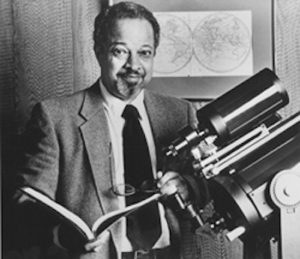
Arthur Walker
*Arthur Walker was born on this date in 1936. He was a Black Solar Physicist and educator. This form of science focuses on many aspects of the solar system.
The only child of Cuthbert and Hilda Walker from Cleveland, Ohio, Arthur Bertram Cuthbert Walker Jr. was close to his many cousins. In 1941, Walker's family moved to New York, where his father established his law practice. Arthur Bertram Cuthbert Walker Jr.’s paternal grandfather was James Henry Walker, a schoolmaster from Barbados.
Young Walker loved science. His parents supported him, and his mother, Hilda, was especially key in his development. She organized parents at his elementary school to fight the problem of teachers leaving the school during the day for errands. This led to a transfer to a new school outside their district. There, Arthur discovered the library and science. He wanted to study the universe like Albert Einstein.
His first love was chemistry, but when his teacher tried to discourage him, Hilda stepped in again and told the teacher in no uncertain terms that her son would study whatever he pleased. When Walker decided to pursue physics, his mother encouraged him to apply to the Case Institute of Technology in Cleveland. Walker earned a baccalaureate degree in physics with honors from there in 1957. He earned a master's degree in 1958 and a doctorate in 1962 from the University of Illinois. His dissertation was on using radiation to produce the particles that bind protons and neutrons together in the atomic nucleus.
That same year, he joined the U.S. Air Force as a 1st lieutenant in the Air Force Weapons Laboratory. He developed an instrument for an experiment involving a rocket launch of a satellite. This Outpost measured Van Allen belt radiation in the Earth's magnetic field, which affects satellite operation. Walker left the service in 1965 and joined the Space Physics Laboratory of the Aerospace Corporation, where for nine years, he conducted pioneering physics experiments to study the sun and the Earth's upper atmosphere. Walker was a professor of physics at Stanford University from 1974 until 2001.
His scientific field of expertise was extreme ultraviolet (EUV) astronomy, primarily related to the solar corona. He was the first astronomer to exploit the then-new technology of Multilayer coated optics to construct systems that could produce images using extreme ultraviolet radiation. The Multilayer coating produces a mirror that is an efficient reflector in the extreme ultraviolet portion of the electromagnetic spectrum. Usually, this type of radiation is strongly absorbed by most materials, making the fabrication of refractive optical systems impossible.
However, a thin film coating produced with thin (40nm or less) alternating layers of low and high atomic weight materials, which is then deposited on a thick optical substrate, can make a mirror. Mirrors coated with these layers exhibit high reflectivity in the Extreme Ultraviolet portions of the Electromagnetic Spectrum. They can be used to form high-precision imaging systems capable of imaging the sun. Even the Earth's atmosphere strongly absorbs EUV radiation; therefore, taking an EUV picture of the sun requires spaceborne cameras.
A spaceborne experiment that Dr. Walker and his collaborators performed resulted in the first Extreme Ultraviolet image of the Sun and Solar Corona. This image was on the front cover of the November 1988 issue of Science Magazine. The courageous decision by Dr. Walker and his team to use a spaceborne experiment in 1980 was an untried and unproven technology. This led to increasing interest in the use of EUV Multilayer coating technology. This technology, refined and developed, is still used today and was used in manufacturing microchips by 2006.
Arthur Walker died on April 29, 2001. He encouraged non-whites and women to pursue careers in science, and among his students was NASA Astronaut Sally Ride.